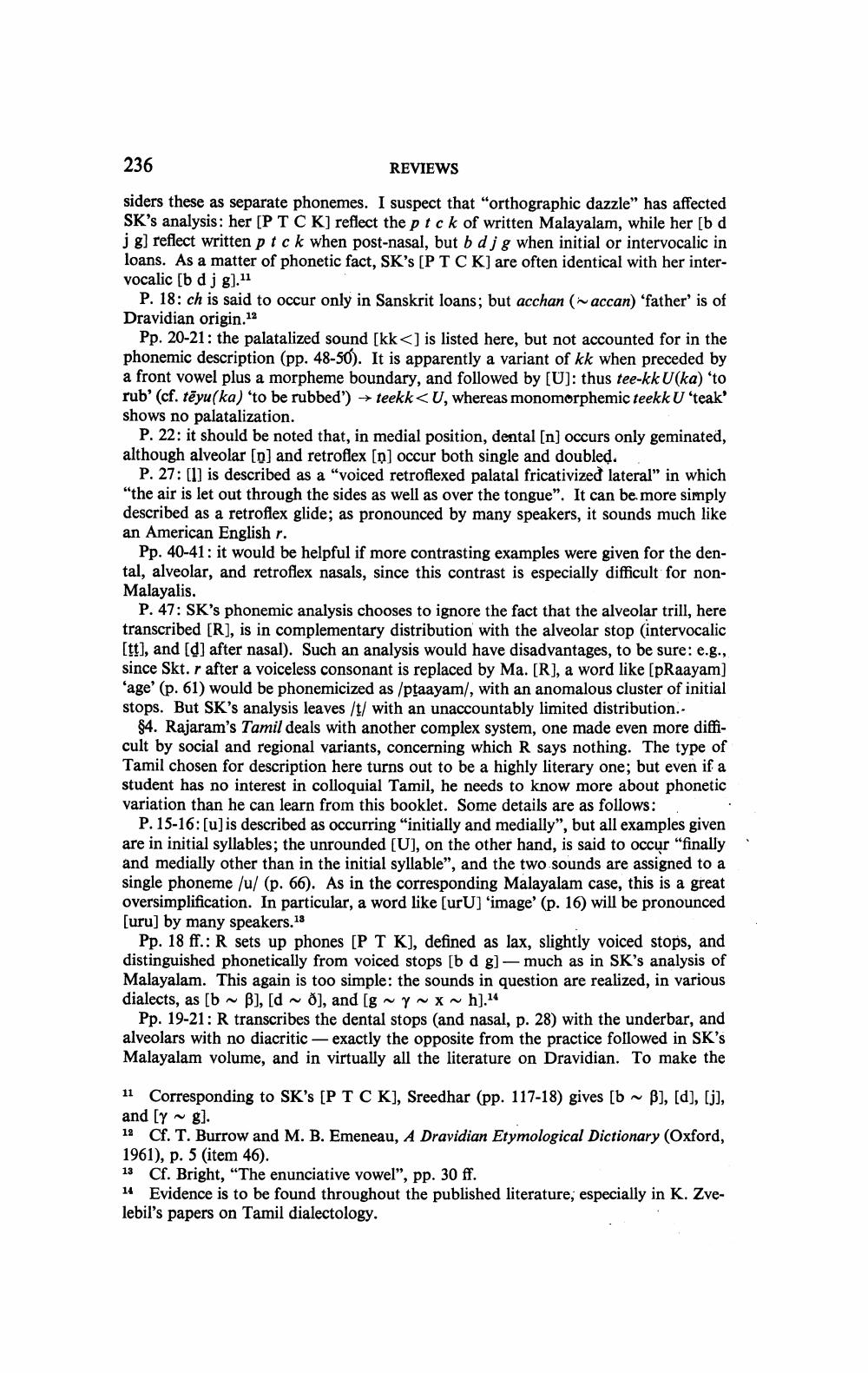________________ 236 REVIEWS siders these as separate phonemes. I suspect that "orthographic dazzle" has affected SK's analysis: her [P TCK) reflect the ptck of written Malayalam, while her [b d j g) reflect written pack when post-nasal, but b dj g when initial or intervocalic in loans. As a matter of phonetic fact, SK's [PTCK) are often identical with her intervocalic [b dj g].11 P. 18: ch is said to occur only in Sanskrit loans; but acchan (accan) 'father' is of Dravidian origin.12 Pp. 20-21: the palatalized sound [kk<] is listed here, but not accounted for in the phonemic description (pp. 48-50). It is apparently a variant of kk when preceded by a front vowel plus a morpheme boundary, and followed by [U]: thus tee-kk U(ka) 'to rub' (cf. teyu(ka) 'to be rubbed') teekk<U, whereas monomorphemic teekk U 'teak' shows no palatalization. P. 22: it should be noted that, in medial position, dental (n) occurs only geminated, although alveolar (n) and retroflex Inl occur both single and doubled. P. 27: (l) is described as a "voiced retroflexed palatal fricativized lateral" in which "the air is let out through the sides as well as over the tongue". It can be more simply described as a retroflex glide; as pronounced by many speakers, it sounds much like an American English r. Pp. 40-41: it would be helpful if more contrasting examples were given for the dental, alveolar, and retroflex nasals, since this contrast is especially difficult for nonMalayalis. P. 47: SK's phonemic analysis chooses to ignore the fact that the alveolar trill, here transcribed [R], is in complementary distribution with the alveolar stop (intervocalic (tt), and (d) after nasal). Such an analysis would have disadvantages, to be sure: e.g., since Skt. r after a voiceless consonant is replaced by Ma. (R), a word like (pRaayam] 'age' (p. 61) would be phonemicized as /paayam/, with an anomalous cluster of initial stops. But SK's analysis leaves /t/ with an unaccountably limited distribution.. 84. Rajaram's Tamil deals with another complex system, one made even more difficult by social and regional variants, concerning which R says nothing. The type of Tamil chosen for description here turns out to be a highly literary one; but even if a student has no interest in colloquial Tamil, he needs to know more about phonetic variation than he can learn from this booklet. Some details are as follows: P. 15-16:[u]is described as occurring "initially and medially", but all examples given are in initial syllables; the unrounded [U], on the other hand, is said to occur "finally and medially other than in the initial syllable", and the two sounds are assigned to a single phoneme /u/ (p. 66). As in the corresponding Malayalam case, this is a great oversimplification. In particular, a word like [urU] 'image' (p. 16) will be pronounced [uru] by many speakers.18 Pp. 18 ff.: R sets up phones (P T K), defined as lax, slightly voiced stops, and distinguished phonetically from voiced stops [b d g] - much as in SK's analysis of Malayalam. This again is too simple: the sounds in question are realized, in various dialects, as [b ~ B], [d ~ 0], and [g ~y~x~h].14 Pp. 19-21: R transcribes the dental stops (and nasal, p. 28) with the underbar, and alveolars with no diacritic - exactly the opposite from the practice followed in SK's Malayalam volume, and in virtually all the literature on Dravidian. To make the 11 Corresponding to SK's (PTC K), Sreedhar (pp. 117-18) gives [b ~ B], [d], [j], and [y ~ g]. 12 Cf. T. Burrow and M. B. Emeneau, A Dravidian Etymological Dictionary (Oxford, 1961), p. 5 (item 46). 13 Cf. Bright, "The enunciative vowel", pp. 30 ff. 14 Evidence is to be found throughout the published literature, especially in K. Zvelebil's papers on Tamil dialectology.




